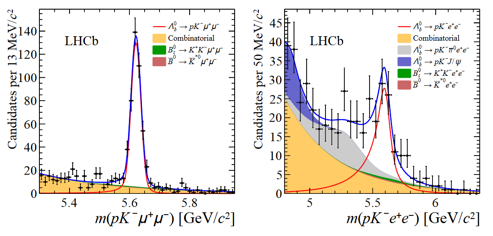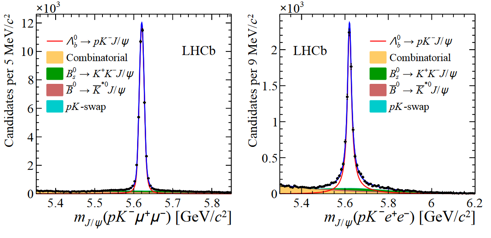Today the LHCb Collaboration submitted for publication a measurement of the ratio RpK. This tests a principle of the Standard Model of particle physics known as “lepton universality“, which states that the laws of physics treat the three charged leptons (electrons, muons and taus) identically, except for differences due to their different masses.
The ratio RpK describes how often a Λb0 baryon decays to a proton and a charged kaon and either a muon and anti-muon pair (pK–μ+μ–) or an electron and anti-electron pair (pK–e+e–). The decays involve the transformation of a beauty quark into a strange quark (b→s) plus a lepton pair (μ+μ– or e+e–), a process that is highly suppressed in the Standard Model but which could be affected by the existence of new particles, whose masses could be too high to be produced directly at the Large Hadron Collider.
LHCb has studied a number of other such ratios that compare beauty particle decays to different leptons (see RK, RK*0, R(D*) and R(J/ψ)). These results revealed hints of deviations from lepton universality, none of which was significant enough to constitute evidence of new physics. However, according to theorists who study possible extensions of the Standard Model, taken together these deviations suggest an interesting and coherent pattern. The measurements use the technique of blind analysis, in which the physicists analysing the data do not know the result until the analysis method is finalized and frozen, following an extended review within the collaboration.
To minimise the influence of detector and other experimental effects, LHCb physicists used a “double ratio” method in which RpK is divided by another ratio, rJ/ψ. The true value of rJ/ψ is known to be very close to 1, but it would be influenced by detector effects in a similar way to RpK. This gives an extra layer of protection: the scientists study and correct for all known experimental effects, but if any unknown effects slip through they would cancel in the double ratio between RpK and rJ/ψ. In more detail, RpK is defined as the ratio of probabilities that a Λb0 decays to pK–μ+μ– or pK–e+e– (within particular mass ranges for the pK and μ+μ– or e+e– pairs; see below), and rJ/ψ is defined as the ratio of probabilities that a Λb0 decays to J/ψpK– with J/ψ→μ+μ– vs e+e–. The double ratio method greatly reduces systematic uncertainties related to the different experimental treatment of muons and electrons, which largely cancel in the double ratio. In particular, the use of the double ratio method means that the detection efficiency of the decay Λb0→pK–e+e– only needs to be known relative to that of Λb0→J/ψ(→e+e–)pK–, rather than Λb0→pK–μ+μ–. Moreover, J/ψ meson decays into μ+μ– and e+e– pairs are known to respect lepton universality at the 0.4% level.
To make the statistical analysis simpler, the main result reported in today’s paper is in fact the inverse of RpK, ie. R-1pK; this just means that the ratios of decay probabilities are computed by dividing the modes with an e+e– by the modes with a μ+μ–, rather than the other way around. This puts the smaller electron yields in the numerator, making the uncertainty of the final result more symmetrical.
The figures show the measured invariant mass distributions of Λb0 baryons for the four decay modes used in the double-ratio measurement, each with a clear peak around the Λb0 baryon mass.
The analysis is performed in the range 0.1<q2<6.0 GeV2/c4, where q2 is the invariant mass squared of the μ+μ– or e+e– pair, and requiring the pK– mass to be less than 2.6 GeV/c2, using proton-proton collision data corresponding to an integrated luminosity of 4.7 fb-1 recorded at center-of-mass energies of 7, 8 and 13TeV. The value of R-1pK is measured to be 1.17+0.18-0.16±0.07, where the first uncertainty is statistical and the second systematic. For comparison with other lepton universality tests, RpK is computed to be RpK=0.86+0.14-0.11±0.05, which is compatible with 1 within one standard deviation. It is also in agreement with previous LHCb results in the lepton universality tests with B mesons, RK and RK*, which found hints that decays with μ+μ– pairs occurr at lower rates than those with e+e– pairs (i.e. R<1). The results of R-1pK measurement presented here show the same tendency, though substantially more data will be needed to confirm or exclude a possible New Physics interpretation. This first test of lepton universality with B baryons was possible thanks to the first observation of the Λb0→pK–e+e– decay. It is also worth noting that the current analysis is sensitive to different experimental uncertainties from the previous lepton universality tests performed with B mesons, and therefore provides a complementary test of the Standard Model.
Read more in the LHCb paper, in the CERN Courier article and also in the CERN Update in English and French..



